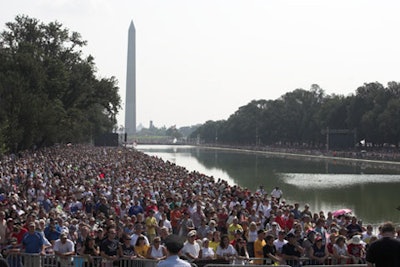
As Jon Stewart and Stephen Colbert’s dueling rallies on October 30 continue to garner headlines across the country, planners from Comedy Central are in the midst of obtaining permits, reserving portable bathrooms, and checking off the long list of other requirements that come with an event on the National Mall. For first-time hosts, this historic national space comes with plenty of challenges. To identify the pitfalls others have faced, we reached out to two veteran planners and a vendor who have hosted multiple events in the shadow of the Washington Monument and the Capitol. Here's what they shared about planning an event on America’s front yard.
1. It’s all about the permits.
Planning an event on the mall begins—and might unexpectedly end—with the permitting process. Just because you want to have an event on the mall doesn’t mean it’s going to take place. Every aspect of the gathering has to be cleared with the National Park Service, which typically issues the final permit one to two weeks prior to the event date. “Expecting and preparing for changes to your original plan is one of the best ways to endure the process,” said Kelley Gillespie, who has produced six events on the mall in 2010 as the senior operations manager for Capitol Services Inc. “Your event will not happen without the permit, so a high level of flexibility is needed both in terms of your event plan and the client who is paying for it."
2. Size matters.
Attendance impacts everything from the level of security to the type of stage and sound system. But estimating attendees of a free and open event on the mall can be a tricky proposition, said Dave Sonntag of CatalystETC, who has produced multiple events on the mall, including the annual Library of Congress Book Festival. “There isn’t really an exact science to it because of the large number of factors that can affect how many people turn out. What time of year or day? Is there a celebrity in attendance? How much advertising is the client doing? What was the attendance at last year’s event? The answers to these questions are a good place to start when you are trying to narrow down crowd estimates.”
Finding a solid number becomes even harder when you are planning a first-time event. When Gillespie worked on Glenn Beck's Restoring Honor rally in August, she ended up relying on a simple but effective online registration system through the event’s Web site, and she consistently checked the chatter on social media sites like Facebook. The team also got word that groups were organizing bus trips to the rally, so they set up a separate online registration system for all buses traveling to Washington. This offered rough estimate of the number of people, and allowed Gillespie to alert the city about the number of buses that would need parking throughout the weekend.
3. Experience counts.
Delivering the staging, tents, lights, and all of the other goods needed for an event on the mall is not like an average conference center load-in. Rules and regulations along with load-in and drop-off locations can change with each gathering and producers are responsible for educating their vendors. With so many complications, it can help to use companies familiar with the location’s peculiarities. And there’s an easy way to find them. “One of the hidden gems for planners that haven’t worked an event on the mall is that the National Park Service keeps a list of vendors for all the services that you may need for your event—planning and management, audiovisual, tenting, power, restrooms, and decor,” Sonntag said. “With that said, NPS can’t and does not officially recommend a specific company. This list just includes companies they have worked with in the past without incident, which is a great starting point for planners.”
4. Play nice with the agencies.
“The right attitude goes a long way when working with the National Park Service, United States Park Police, District Department of Transportation, Capitol Police, District of Columbia Police Department, and other agencies that you may be working with, depending on the scale and size of your event,” Sonntag said. “These agencies have a lot of events that happen back-to-back all year, and to be honest, your event is just another event on the calendar.”
Gillespie added, “These events are not convenient for the agencies, and they are doing their best to keep everyone and everything on the mall safe and intact, and they are doing this on a limited budget. It’s in everyone’s best interest to be a team player, follow the regulations, and work with powers that be.”
5. Know the rules … but plan for changes.
Do tents have to be staked in the ground or connected to a barrel? What type of turf protection is required when driving trucks on the mall? What kind of signage is allowed? These are all important questions, and there are rules and regulations that govern almost every aspect of an event on the mall. But those rules and regulations can change at any time. The event team at Hargrove, which has produced five events on the mall in 2010, advises never to assume that the rules are the same as the last time you worked on an event there. Vendors and planners should constantly check current regulations to make sure they are in adherence.
6. Pad the budget.
“If a client is willing to invest the time and planning needed to produce an event on the mall, they also have to be willing to invest financially. Simply put, it is not cheap to do an event on the mall,” Gillespie said. When her team plans a budget, they always have a section for unknown expenses, a figure that runs between 5 and 8 percent of the total budget. “Yes, the clients aren’t exactly happy about this, but it is part of doing business, and it is something you can almost always expect to happen,” she said. “Unexpected bills in the thousands of dollars are not uncommon with these large-scale events.”
7. Hope for the best, plan for the worst.
A comprehensive plan is required by the the park service before the event can begin, and that plan also has to include contingencies for extreme weather or emergency situations no producer can control. Planning for inclement weather was at the top of the list of tips from Carla Hargrove McGill, president and chief operating officer of Hargrove. “As with any outdoor event, Mother Nature is not always mindful of your event plans. Be sure to plan worst-case scenarios for weather on event days, installation, and dismantle,” she said.
Gillespie had to deal with high temperatures and an older demographic during the Restoring Honor rally, which tested the limits of her medical emergency planning. “We had the required amount of ambulances on site, but midway through the program we realized we needed more. As we always do, we had a secondary plan in place. We had a private ambulance service on hold, and we called them in to help, and we were able to solve the issue without any major problems.”



















